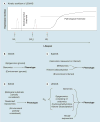Gene × environment interaction by a longitudinal epigenome-wide association study (LEWAS) overcomes limitations of genome-wide association study (GWAS)
- PMID: 23244313
- PMCID: PMC4195244
- DOI: 10.2217/epi.12.60
Gene × environment interaction by a longitudinal epigenome-wide association study (LEWAS) overcomes limitations of genome-wide association study (GWAS)
Abstract
The goal of genome-wide association studies is to identify SNPs unique to disease. It usually involves a single sampling from subjects' lifetimes. While primary DNA sequence variation influences gene-expression levels, expression is also influenced by epigenetics, including the 'somatic epitype' (G(SE)), an epigenotype acquired postnatally. While genes are inherited, and novel polymorphisms do not routinely appear, G(SE) is fluid. Furthermore, G(SE) could respond to environmental factors (such as heavy metals) and to differences in exercise, maternal care and dietary supplements - all of which postnatally modify oxidation or methylation of DNA, leading to altered gene expression. Change in epigenetic status may be critical for the development of many diseases. We propose a 'longitudinal epigenome-wide association study', wherein G(SE) are measured at multiple time points along with subjects' histories. This Longitudinal epigenome-wide association study, based on the 'dynamic' somatic epitype over the 'static' genotype, merits further investigation.
Figures

Similar articles
-
Residential surrounding greenness and DNA methylation: An epigenome-wide association study.Environ Int. 2021 Sep;154:106556. doi: 10.1016/j.envint.2021.106556. Epub 2021 Apr 13. Environ Int. 2021. PMID: 33862401
-
Measuring epigenetics as the mediator of gene/environment interactions in DOHaD.J Dev Orig Health Dis. 2015 Feb;6(1):10-6. doi: 10.1017/S2040174414000506. Epub 2014 Oct 15. J Dev Orig Health Dis. 2015. PMID: 25315715 Review.
-
Epigenome-wide association study of DNA methylation in panic disorder.Clin Epigenetics. 2017 Jan 21;9:6. doi: 10.1186/s13148-016-0307-1. eCollection 2017. Clin Epigenetics. 2017. PMID: 28149334 Free PMC article.
-
Epigenetic drift in the aging genome: a ten-year follow-up in an elderly twin cohort.Int J Epidemiol. 2016 Aug;45(4):1146-1158. doi: 10.1093/ije/dyw132. Epub 2016 Aug 6. Int J Epidemiol. 2016. PMID: 27498152
-
Epigenetics of dementia: understanding the disease as a transformation rather than a state.Lancet Neurol. 2016 Jun;15(7):760-774. doi: 10.1016/S1474-4422(16)00065-X. Epub 2016 May 9. Lancet Neurol. 2016. PMID: 27302240 Review.
Cited by
-
Gene-environment interactions in Alzheimer disease: the emerging role of epigenetics.Nat Rev Neurol. 2022 Nov;18(11):643-660. doi: 10.1038/s41582-022-00714-w. Epub 2022 Sep 30. Nat Rev Neurol. 2022. PMID: 36180553 Review.
-
Transgenerational latent early-life associated regulation unites environment and genetics across generations.Epigenomics. 2016 Mar;8(3):373-87. doi: 10.2217/epi.15.117. Epub 2016 Mar 7. Epigenomics. 2016. PMID: 26950428 Free PMC article.
-
Epigenetic dysregulation of brainstem nuclei in the pathogenesis of Alzheimer's disease: looking in the correct place at the right time?Cell Mol Life Sci. 2017 Feb;74(3):509-523. doi: 10.1007/s00018-016-2361-4. Epub 2016 Sep 14. Cell Mol Life Sci. 2017. PMID: 27628303 Free PMC article. Review.
References
-
- Goldstein DB. Common genetic variation and human traits. N Engl J Med. 2009;360(17):1696–1698. - PubMed
-
- Kraft P, Hunter DJ. Genetic risk prediction – are we there yet? N Engl J Med. 2009;360(17):1701–1703. - PubMed
-
- Hirschhorn JN. Genomewide association studies – illuminating biologic pathways. N Engl J Med. 2009;360(17):1699–1701. - PubMed
-
- Galton F. Regression towards mediocrity in hereditary stature. J Anthropol Inst. 1886;15:246–263.
Publication types
MeSH terms
Grants and funding
LinkOut - more resources
Full Text Sources
